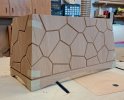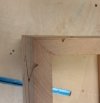I am relining the sides of my driveway with full size 6x6's and my geometry is a little rusty. The first cut is a 60 degree angle going from top to bottom (first pic) in each piece which works as long as the run is straight. My problem is when the run changes direction (second pic). The cuts come out like a 'rhombus'(I think that is the term) and the 2 pieces don't match. I am getting the feeling that this has no solution. Any ideas??


You are using an out of date browser. It may not display this or other websites correctly.
You should upgrade or use an alternative browser.
You should upgrade or use an alternative browser.
Compound Angles
- Thread starter TIDE500
- Start date
From the drawing, it looks like you are about 30 degrees off a straight line. Cutting each end of the mating boards @15 degrees should match them up. You could lay straight edge (read that "a board) across the joint with the center line of straight edge at the peak where your boards meet and center the other end across the gap, mark and cut.
It's a compound miter if you want to keep the 60 degree connection.
It's a compound miter if you want to keep the 60 degree connection.
Sorry for the pictures. Let me see if I can explain it better. I am lining my driveway with 6 x 6's ( full size). Rather than butting them together, I want to cut them at a bevel (see pic #1). This works fine if the driveway is straight. When the driveway turns, and I try to match that angle, the 2 pieces won't mate up again.
Sorry for the pictures. Let me see if I can explain it better. I am lining my driveway with 6 x 6's ( full size). Rather than butting them together, I want to cut them at a bevel (see pic #1). This works fine if the driveway is straight. When the driveway turns, and I try to match that angle, the 2 pieces won't mate up again.
Then just bisect the angle and butt that one joint on the turn. It will still look the same from the face as the other joints.
If I understand correctly, the 60deg cuts you show on n the first pic are an intended as a scarf feature so the joint does not gap when the wood shrinks. If that is correct, I don’t believe the scarf can be made to work at anything other than 180deg between the pieces. What Pop-pop said may be your best/only option.
Bisect the angle of the turn and then set the saw up for a 30 degree bevel. Unless you have a big 16" circluar saw, you will probably need to cut as far as possible with a regular circular saw and complete the cuts with a Sawzall or hand saw. Good luck.
If your angle is in 2 different directions, you cannot mate rectangular surfaces
Maybe I misunderstand, but what I think you are describing is a compound miter. Very common. Here's one I happened to do today. Front and side faces angle in at 8 degrees and the corner is 90 degrees. Rectangular faces mate.If your angle is in 2 different directions, you cannot mate rectangular surfaces
Attachments
but the joint is in one plane. He was describing a two plane system.
I finally see what you are doing - didnt realize it was a scarf joint  .
.
As @longreyhair said there is no solution when the boards remain in the same plane.
My bad.
As @longreyhair said there is no solution when the boards remain in the same plane.
My bad.
LATEST FOR SALE LISTINGS
-
-
-
SOLD -- $75: Gast moa v113 Vacuum Pump Veneer, 60" bag and board
- Started by peterdnight
- Replies: 1
-
GONE: Gladiator 5 cleats, 10 hangers, Paper Towel and Shelf
- Started by peterdnight
- Replies: 3
-
SOLD -- $100 Makita mac700 portable air + grex pin nailer + 2 others + 50' hose
- Started by peterdnight
- Replies: 1


